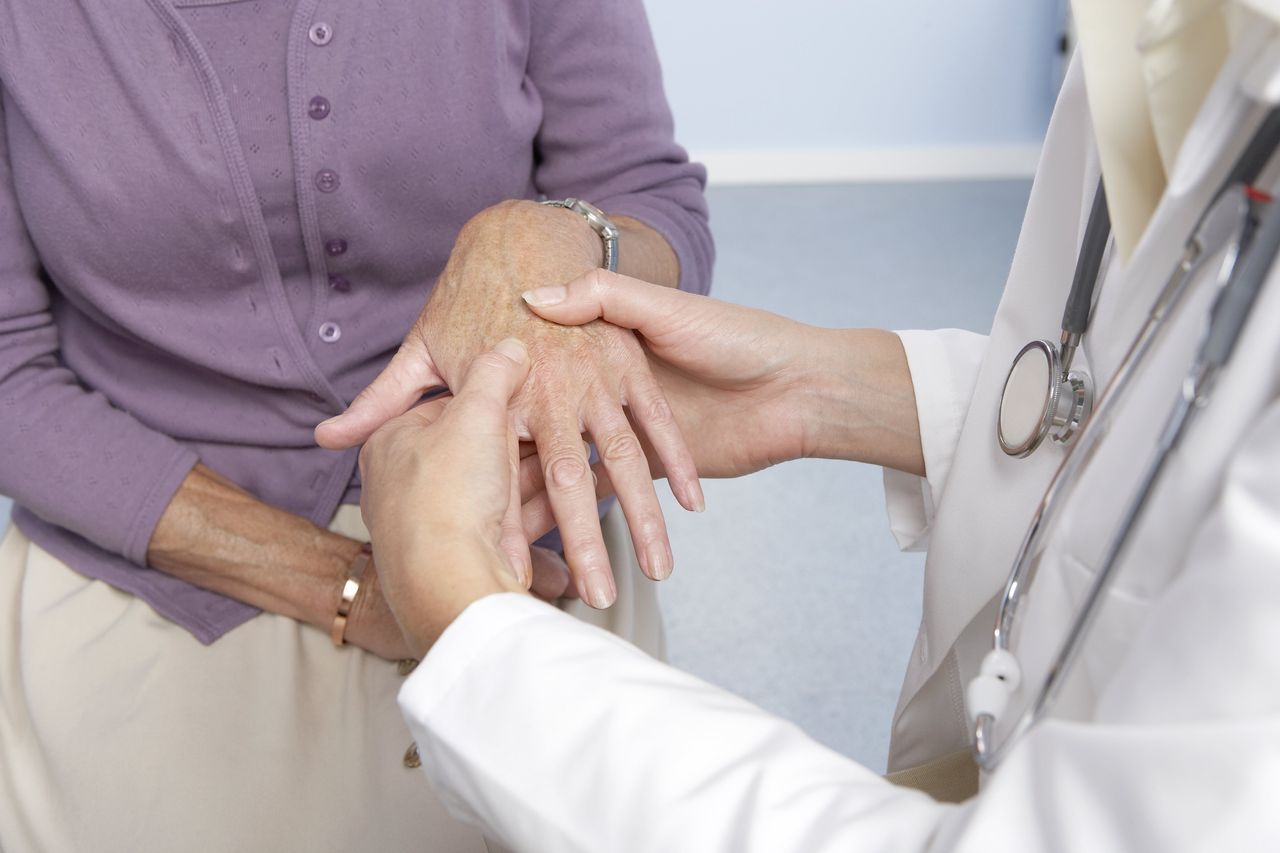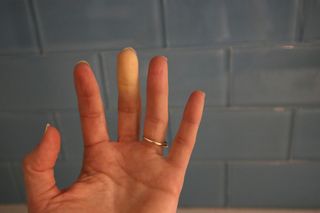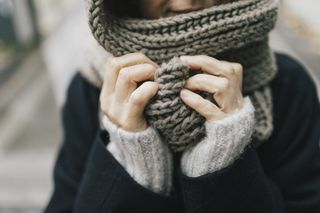Raynaud's disease: the 'cold hand' syndrome that affects one in five of us
There are some debilitating symptoms...

For many of us the cold is a mere irritation, but for people with this Raynaud's disease, cold weather means something much more serious.
In the depths of the winter, we all suffer with the extreme weather. And often, we'll feel the icy cold most keenly at our extremities - our fingers, toes, and our faces - in fact, pretty much anything that's not wrapped up in multiple layers.
But for one in five of the UK population, the pain of a frosty, cold day is made much, much worse, because of a little-discussed syndrome called Raynaud's (pronounced: Ray-nose) disease.
Primary Raynaud’s phenomenon is a relatively common condition, affecting up to 10 million people within the UK, according to the NHS. That's one in five of us, says the charity Scleroderma and Raynaud's UK.
What is Raynaud's disease?
The condition affects your circulation, and can stop the blood in your body from flowing to your extremities e.g your fingertips and your toes/feet.
People who suffer with Raynaud's syndrome are particularly sensitive to changes in temperature, and the changes can cause extreme discolouration in the fingers and feet.
Dr Fatima Salaiman, Head of Research and Services at Scleroderma and Raynaud's UK, said, "People who have primary Raynaud’s may experience their fingers and toes turning white, then blue, then red as part of a reaction to the change in temperature."
GoodtoKnow Newsletter
Parenting advice, hot topics, best buys and family finance tips delivered straight to your inbox.
So what exactly causes Raynaud's? It turns out, it's not just the cold. Dr Fatima said, "We still don’t understand what causes Raynaud’s, however we do know that lifestyle factors such as smoking and stress can exacerbate the symptoms."
Scientifically, it's caused by disruptions in how the nervous system controls blood vessels - but exactly what is behind such disruption hasn't yet been figured out. However, there is some evidence that Raynaud's syndrome could be an inherited condition, with cases of the disease seen to run in families.
Who is affected by Raynaud's disease?
According to SRUK, more women than men find themselves suffering from Raynaud's disease, "with some estimates suggesting that up to four times more women than men are affected".

And while it might generally be considered more of a 'winter disease', because of its associations with cold weather, it actually affects sufferers all year round. In fact, people with Raynaud's can be triggered by something as simple as buying their weekly shop. According to Dr Fatima, "it’s not just the colder weather that causes attacks".
She continued, "Other exposures to cold can set off symptoms. It might be something simple like walking through the cold aisle in a supermarket, or reaching into your freezer."
For 26-year-old Lisa, her Raynaud's kicked in over two years ago, after first noticing her symptoms whilst driving in the cold. She explained, "Holding my hands on the steering wheel in the cold, before the car temperature rose, was when it would happen and how I first noticed it.
"Now, it's triggered mainly when I feel cold, but very occasionally it can flare up if I feel very stressed or anxious."
Raynaud's disease symptoms
Raynaud's disease symptoms can be relatively straightforward, and you usually won't feel any symptoms aside from at the site of the affected area.
Raynaud’s symptoms may include:
- Cold fingers and toes
- Colour changes in the skin in response to changes in temperature or stress
- Colour changes in the affected area from white, to blue/purple and then red
- Numbness, tingling or pain in the affected area
- Stinging or throbbing pain upon warming, or stress relief

Lisa explained that for her, Raynaud's disease makes it feel like all the 'life' has gone out of her hands or feet.
She told GoodtoKnow, "The feeling is very uncomfortable and strange - it's a numb feeling, but not at all like when you lie on a limb and it goes numb - it's more like your hand/food goes almost rubbery. The area goes chalk white and it loses proper feeling. It's hard to describe to someone who's not experienced it. It's as though the life has gone from the affected area temporarily and you have to coax it back in."
How long does a Raynaud's flare-up last?
For sufferers, a Raynaud's flare-up can last for minutes or hours, leaving them in debilitating discomfort. "For me it takes anywhere from 10 to 20 minutes to go back to normal, but sometimes it's longer if I can't get heat to the area." Lisa shared.
"Luckily, I don't yet experience pain, but it seems to progress each year so I do worry that that will come in the future."
As well as Primary Raynaud's phenomenon - or white finger syndrome, as it is sometimes nicknamed - there is also secondary Raynaud's, which is in fact a rarer, more severe version of the condition, affecting an estimated 300,000 people in the UK.
Dr Fatima said, "People who have secondary Raynaud’s will experience severe versions of these attacks and often also develop digital ulcers or open wounds on their fingertips. They are more likely to have Raynaud’s symptoms throughout the year, rather than just during the cold weather."
And while there are rarely health risks with primary Raynaud's, secondary can present some big ones.
"People who have been diagnosed with secondary Raynaud’s are at risk of developing an underlying autoimmune condition such as lupus, rheumatoid arthritis or systemic scleroderma." Dr Fatima continued.
Raynaud's disease prevention and treatment
At the moment, there is no 'cure' as such, for Raynaud's disease. Dr Fatima reassured, however, that "the condition can be managed with practical interventions and does not usually affect someone’s quality of life."
Essentially, it can be effectively controlled if with a couple of practical tips that can be incorporated into everyday life, although preventing flare-ups completely is unlikely.
The key is to keep warm in fluctuating temperatures, so SRUK recommend wearing thick gloves, and lots of thing layers in the cold weather, as well as incorporating gentle exercise into your schedule in order to stimulate your circulation.
At night, they advise using a hot water bottle or electric blanket to help you adjust to the cooler temperature of the bed. Flannelette night clothes, a night cap, bed socks and gloves can also help Raynaud's sufferers at night, when temperatures particularly plummet.
And, if you find yourself sat in an air conditioned office for work, they advise wearing a scarf to stop the cold air from circulating your neck and triggering your Raynaud's.
READ MORE: Norovirus: How to avoid it and what to do if you're victim to the winter vomiting bug

Stress is also thought to make Raynaud's disease worse, so SRUK state that stress relief practises such as mindfulness can be helpful in managing the condition. Dr Fatima also said, "If you are a smoker, SRUK also highly recommend that you seek help in quitting smoking through your GP or the NHS website for example."
However, if you find yourself with secondary Raynaud's, or more severe symptoms, Dr Fatima has explained that there are prescription treatments available, such as nifedipine. According to the NHS, it works to lower your blood pressure, to make it easier for you to pump blood around your body. However, it can come with side effects, such as headaches and constipation, and is only available on a prescription from your doctor.
And, it's important to note that nifedipine may not be suitable for people who are trying to get pregnant, pregnant or breastfeeding women, people with liver disease or diabetes, or people with heart problems.
Lisa revealed that taking precautionary measures whilst travelling and at work help to alleviate her symptoms.
"To try and prevent flare ups, I have a heater at work, and I try to limit my exposure to the cold, including wearing slippers in the house and gloves when I'm in the car. But other than that I've yet to find anything that works once it has started to flare."
If you are seeking ways to alleviate your Raynaud's syndrome, visit your GP who may be able to offer further help and advice.
Is it ok to breastfeed if you develop Raynaud's?
Women who have Raynaud's in their fingers and toes may develop 'Raynaud's of the nipple' when they become pregnant - or, when they start to breastfeed. Dr Fatima explains that while it is entirely safe to breastfeed your child if you have Raynaud's disease, it may prove tricky - but not impossible.
Dr Fatima said, "Breastfeeding mothers may experience difficulties with breastfeeding if their Raynaud’s is undiagnosed, however following the above practical tips on keeping warm and reducing stress can help to lessen these issues."
It may become difficult for example, exposing your breast in order to feed your child. But, it is doable if you do your best to look after the condition. Treatment should be handled with the breast in the same way it should be dealt with for your fingers and toes - keep warm, avoid exposure to the cold, and reduce stress.
Raynaud's in children
Of course, it won't only affect adults, with Raynaud's being particularly common with teenagers, although rare in babies and young children.
SRUK advise many of the same tips for managing Raynaud's in children, but have also shared some child-specific tips too. On their website, they explain that parents should be cautious when bathing a young child with the disease, stating that, "they are more susceptible to hot temperatures".
They continued, "It is best to fill a bath with lukewarm water and top it up with warmer water as their body adapts to it."
Precautions should also be taken at school, with SRUK advising that parents inform the school ASAP and explain that special allowances need to be given during PE or any outdoor activities.
For more information on Raynaud's, visit sruk.co.uk, or the NHS website.
You can also contact SRUK's helpline on 0800 311 2756.
Amy is Senior Digital Writer across Woman & Home, GoodTo and Woman, writing about everything from celebrity news to health, fashion and beauty features. When she isn't obsessing over the latest dress drop from Marks & Spencer, you'll most likely find Amy out running, or with a cup of tea in hand ready to dive into a gripping new Netflix series.